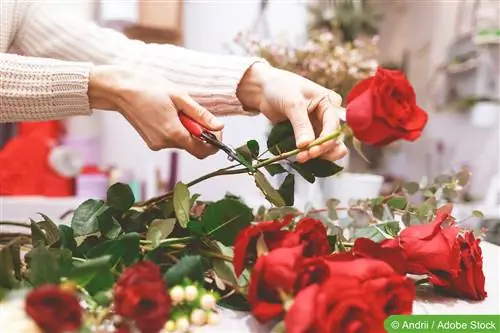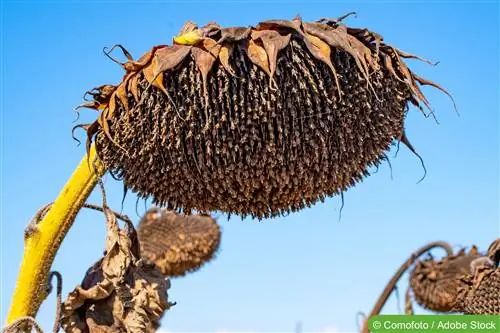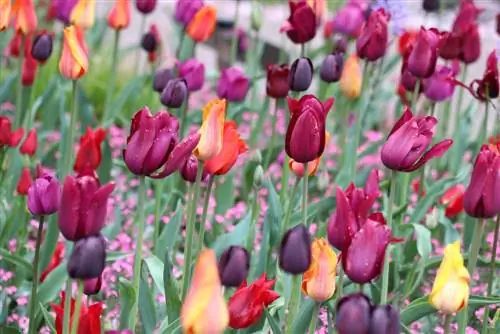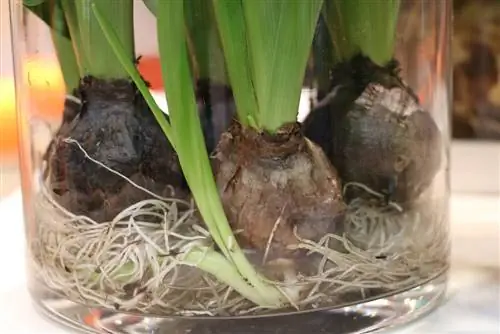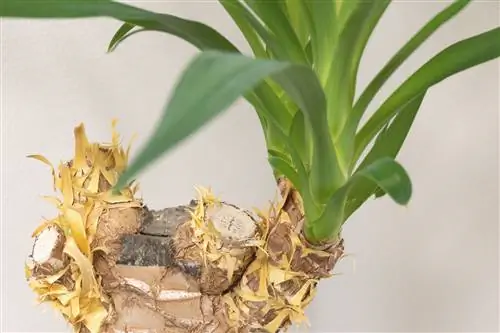- Author admin [email protected].
- Public 2023-12-17 03:39.
- Last modified 2025-06-01 06:48.
For your buddleia, scissors are the baton for the symphony of lavish flowers and seductive scent. Without professional pruning, the majestic flowering bush will soon be nothing more than a shadow of its former self. With these instructions you will receive the gardening know-how to prune your Buddleja davidii correctly at the perfect time. Read here how you can use skillful pruning to extend the flowering period, repair frost damage and prevent invasive spread. This guide also reveals whether you can simply cut off spent flowers.
The best time
Several aspects are relevant when choosing the right date for pruning. A buddleia only blooms on this year's branches. These sprout from the sleeping eyes at the beginning of the vegetation phase and form their buds and flowers at the end of the shoot and on the short side branches. Consequently, the dead branches from the previous year should not stand in the way of fresh growth. The perfect time for pruning measures is late winter, during the months of January and February.
The pruning should be done by the end of February for two reasons.
The buddleia needs enough time for its fresh branches to grow. The later the cut, the later the flowering period begins. Furthermore, the Federal Nature Conservation Act prohibits radical pruning of all bushes and hedges between March 1st and September 30th. In the months before and after, cutting may not be carried out if there are habitats of wild animals in the woods.
Tip:
A buddleia in a pot can be cut back in the fall before putting it away if there is not enough space in the winter quarters for its expansive habit.
Cutting tool tips
A pair of secateurs is usually enough to cut a buddleia. A Buddleja davidii rarely develops thick branches, which are common with other flowering bushes. There is therefore no need to invest in pruning shears or a saw. Since you are dealing with a hard, brittle wood on the butterfly lilac, special attention should be paid to the quality of the cutting tool.
Specialist retailers have two categories of secateurs for pruning trees. Bypass scissors have a curved blade that slides past the opposite cutting edge when the handles are squeezed. Anvil pruners cut the wood by pressing the branch onto a straight cutting surface. Bypass scissors score points with their precise cutting, although hard wood is often caught between the blades, resulting in frayed cuts. This cannot happen with anvil scissors because the anvil projects beyond the sharp blade on both sides. The anvil scissors are therefore more advantageous for cutting hardwood buddleia.
Pruning for large flowers
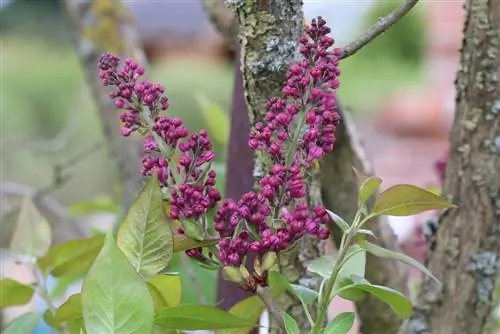
When it comes to care, the buddleia is reserved and modest. In contrast, the flowering shrub does not believe in minimalist restraint when it comes to growth speed. Knowledgeable gardening enthusiasts know how to use this fact to produce a large number of large flower candles with targeted cutting. For this reason, garden butterfly lilacs outdo their uncut counterparts in the wild with their opulent abundance of flowers. How to cut correctly:
- At the time recommended here, examine the bush thoroughly for birds and small animals that have settled there
- If no nests can be discovered, cut back all flower shoots from the previous year by up to two thirds
- Just leave a small remaining piece with 2 sleeping eyes
- Place the scissors a thumb's width above a leaf node
Please note that this pruning focuses on last year's branches. The old wood underneath, from which the shoots branch, remains untouched. Despite the radical pruning, the buddleia gradually gains height and volume over the years.
Tip:
So that a buddleia maintains its youthful vitality, the following measure is added to the pruning from the fifth year onwards: Every other year, remove the two oldest leading branches close to the ground to create space for young ground shoots.
Pruning for a shapely shrub crown
While the radical cut aims to produce the largest possible flower candles, one disadvantage should not be underestimated. Spurred on so vehemently to sprout, the buddleia sprouts rapidly in all directions, at the expense of a harmonious silhouette. At the same time, dense whorls of branches develop over the years, obstructing and shading each other, which can lead to baldness. You can avoid these two problems with a variable cutting height. This is how it works:
- First check the bush for animal inhabitants
- Only cut off favorably spent branches from the previous season by a third
- Short shoots that are less advantageous for shaping by half to two thirds
- Make each cut at a distance of 1 cm above a leaf node
- In addition, thin out the entire bush thoroughly
Take a few steps back every now and then to plan the next intersections. Although this procedure takes a little more time, it is rewarded with an elegant, dense and compact butterfly lilac.
Cut off spent flowers - doubly useful
Many gardening enthusiasts wonder whether they can cut off the withered flowers on the buddleia. This measure is highly recommended for two reasons, which we explain in more detail below:
Long flowering period

Although the flowering period of a Buddleja davidii extends from July to October, a single flower does not last over this long period. As a result, wilted flowers regularly develop over the course of the summer, which impairs the decorative appearance. By cleaning these out, sunlight reaches the buds underneath, which continue the flower festival. Instead of cutting out individual faded flowers, you can also wait until the entire flower dress has withered. If you then cut out everything that has withered in one go, there is a good chance of re-blooming in autumn.
Prevent invasive spread
A buddleia has a reputation for spreading invasively in the garden. To this end, the ornamental shrub produces myriad seeds after the flowers fade. By grabbing the scissors in good time before the capsule fruits grow, you put a stop to this endeavor. As a result, you will have to clean out all the faded flowers again in the fall, even though there is no longer any prospect of fresh buds. Otherwise, the buddleia spreads its countless seeds throughout the bed. These are completely frost-resistant and will germinate the following year in all sunny locations in the garden.
Fix frost damage with scissors - this is how it works
Buddleia is assigned to hardiness zone Z6 b. The flowering bush should therefore be frost-resistant down to -20.4 degrees Celsius. However, under the influence of unfavorable weather conditions, such as persistent wetness and cold wind, frost damage to the branches can occur. In a harsh winter, the shoots will, in the worst case, freeze back very far. A professional pruning back to he althy wood eliminates the problem in early spring. Use the following vitality test to determine up to which point on the shoot you should cut:
- Disinfect a sharp knife or scalpel
- Scrape the bark off the surface of the affected branch
- Brown tissue is dead, green tissue is vital
Now cut off the shoot where there is only green tissue and the bark is not injured. If there is at least one sleeping eye below the cut point, the buddleia will sprout again here.
Special case: Alternate-leaved buddleia
The buddleia family is not limited to the favorite Buddleja davidii, which presents itself with impressive flower candles from July onwards. The alternate-leaved buddleia impresses with elegant, overhanging branches on which dense clusters of flowers are presented.
The Buddleja alternifolia differs from its counterpart in many ways. It blooms at the end of May/beginning of June on the shoots of the previous year. This specific behavior requires a different time for the cut and a modified cutting guide. This is how you professionally cut an alternating-leaved buddleia into shape:
- Tighten the shrub carefully in late winter
- Please check for animal winter guests first
- From the fourth or fifth year onwards, cut off some of the oldest ground shoots at the base
- Immediately after flowering, shorten branches that are too long by up to a third if necessary
The moderate pruning after flowering complies with the requirements of the Federal Nature Conservation Act, according to which light care pruning is permitted between March 1st and September 30th, provided that no birds nest in the branches.
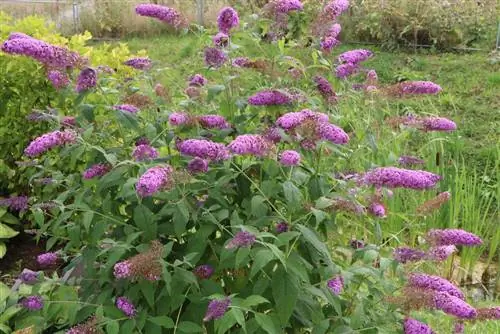
This buddleia species does not receive a radical pruning like Buddleja davidii, as this would result in the majority of the existing buds falling victim to the scissors. However, faded and dried flower spikes can be removed in early summer. Regular thinning in January/February is more important than topiary, as this creates space for young branches that will bloom in abundance within 2 years.
Do not seal small cuts
Wound closure has come under criticism in tree care. As extensive research projects have shown, shrubs and trees have effective self-healing powers that are hindered by sealing the cut surfaces. All small cuts that are smaller than a two euro coin remain untreated.
If larger cuts occur in late winter, just coat the edges of the wound thinly with tree wax or clay. In this way, you protect the dividing cell tissue there from frost and dryness. Just in time for the beginning of the warm season, the cambium will overflow the cut and in this way encapsulate it so that he althy growth is not impaired.
Proper care after cutting
After pruning, a butterfly lilac must sprout from its sleeping eyes. This means a lot of effort for the shrub, which you can support with the following care program:
- Spread a 3 cm high layer of compost with horn shavings on the root disc
- Use the rake to lightly work it into the soil and sprinkle with water or nettle manure
- Administer a liquid fertilizer for flowering bushes in the bucket and water again
- Water regularly with normal tap water during the flowering period
In July, a buddleia is fertilized for the last time so that it matures before the start of winter. By applying a fertilizer with a high potassium content now, you can strengthen winter hardiness. Among the organic fertilizers, comfrey manure fulfills this task excellently, thanks to its high natural potassium content. Alternatively, patent potash, dolomite potash or Thomas potash in low concentrations are possible.
Conclusion
A bushy, busy flowering buddleia requires annual pruning. The best time is during the months of January to the end of February. In order to achieve large flowers, all of the previous year's shoots are radically pruned except for short remaining pieces with 1 to 2 eyes. To ensure a harmonious growth habit, gardeners cut back the dead branches of the previous season at variable heights. Continuous cleaning of withered flowers creates an extra long flowering period and prevents unwanted seeding. If the butterfly lilac receives compost with horn shavings or a mineral-organic liquid fertilizer after pruning, nothing stands in the way of the summer flower fairytale.


